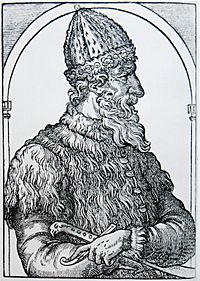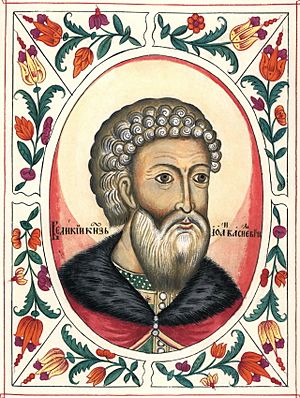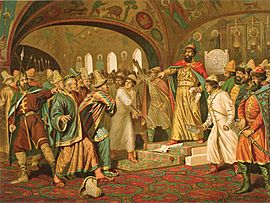Ivan III of Russia facts for kids
Quick facts for kids Ivan III The Great |
|||||
|---|---|---|---|---|---|
| Grand Prince of Moscow | |||||
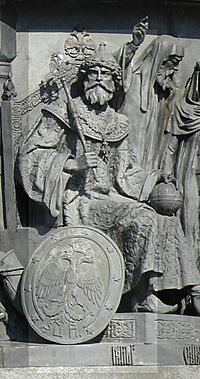
Ivan the Great at the Millennium Monument in Novgorod
|
|||||
| Reign | 1462–1505 | ||||
| Predecessor | Vasily II | ||||
| Successor | Vasily III | ||||
| Wives |
|
||||
| Issue | Ivan Ivanovich Vasili Ivanovich Yury Ivanovich Dmitry Ivanovich Simeon Ivanovich Andrey Ivanovich Еlena Ivanovna Feodosia Ivanovna Eudokia Ivanovna |
||||
|
|||||
| Dynasty | Rurik Dynasty | ||||
| Father | Vasily II | ||||
| Mother | Maria of Borovsk | ||||
Ivan III Vasilievich (Russian: Иван III Васильевич), born on January 22, 1440, in Moscow, was a powerful ruler. He is also known as Ivan the Great. He was the Grand Prince of Moscow and was called "Grand Prince of all Rus".
Ivan the Great is famous for bringing many Russian lands together. He made his state three times bigger. He also ended the rule of the Golden Horde over Russia. Ivan rebuilt the Moscow Kremlin, which is a famous fortress. He helped create the modern Russian state. He was one of the longest-ruling leaders in Russian history. Ivan died on October 27, 1505, in Moscow.
Contents
Early Life and Reign
Ivan's parents were Vasily II and Maria of Borovsk. He started helping his father rule in his later years. When his father died in 1462, Ivan became the Grand Prince.
Ivan continued his family's goal of uniting Russian lands. He was careful and tried to avoid big fights. He preferred to achieve his goals slowly and smartly. Moscow was already a strong state, and its rivals were weaker. This helped Ivan greatly. He also started a big building project in the Kremlin. Italian artists and builders helped make new buildings and stronger walls with towers.
Ivan III ruled for 43 years. He passed his empire to his son, Vasily III, when he died.
Uniting Russian Lands

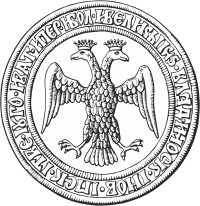
One of Ivan's first big actions was a war with the Republic of Novgorod. Novgorod was a powerful city that had fought Moscow for a long time. Novgorod tried to get help from Lithuania to stay independent. Moscow saw this as a betrayal.
In 1470, Ivan led his army against Novgorod. His generals won two important battles. Novgorod was forced to ask for peace. They agreed to stop working with Lithuania and gave up a large part of their northern lands. They also paid a large sum of money.
Ivan visited Novgorod several times after this. He arrested leaders who supported Lithuania and took their lands. In 1477, some envoys from Novgorod called Ivan their "sovereign." Ivan took this as a sign that Novgorod accepted his rule. When Novgorod denied this and threatened to turn to Lithuania again, Ivan marched his army there.
Novgorod was left alone by Lithuania and surrounded by Moscow's army. On January 15, 1478, Novgorod officially recognized Ivan's direct rule. Later, some people in Novgorod rebelled. Ivan punished them by moving rich families from Novgorod to Moscow and other Russian cities.
Other areas were also added to Moscow's control. Yaroslavl joined in 1463, Rostov in 1474, and Tver in 1485. Ivan also fought wars with his own brothers who wanted more power. He won these wars. Ivan made a new rule that after his relatives died, their lands would go to the Grand Duke, not their own heirs. This helped end the power of smaller princes.
Changes in Government
Under Ivan III, the way Moscow was governed changed a lot. It became more like an autocracy, where the ruler had almost complete power. After the fall of Constantinople, some people thought the Grand Princes of Moscow were the new leaders of the Orthodox world. Ivan liked this idea and started calling himself tsar in letters to other countries.
Ivan's family life also changed things. After his first wife, Maria of Tver, died, he married Sophia Paleologue in 1472. Sophia was related to the last Byzantine emperors. She encouraged Ivan to adopt more imperial ideas and ceremonies. The fancy rules of the Byzantine court and the double-headed eagle symbol were brought to Moscow.
Ivan had a son, Ivan the Young, with his first wife. This son died in 1490. Ivan first named his grandson, Dmitry, as his successor. But later, he changed his mind and chose Sophia's older son, Vasily. Vasily became co-ruler with his father in 1502. Dmitry was put in prison and died there later.
Ivan started to keep his distance from the boyars, who were powerful nobles. The old ways of government, where boyars had a lot of say, disappeared. The ruler became very powerful, and the boyars had to follow his will.
During Ivan III's reign, a new law code called the Sudebnik was created. Ivan wanted Moscow to be as grand as Constantinople. So, he invited many foreign builders and artists to Moscow. One famous Italian architect, Ridolfo di Fioravante, built several cathedrals and palaces in the Kremlin. These buildings are still symbols of Ivan III's power.
Foreign Relations
A very important event during Ivan III's rule was Russia breaking free from the Tatar yoke. For a long time, Russian lands had to pay tribute to the Golden Horde. In 1480, Ivan refused to pay this tribute to Akhmat Khan. The Russian and Tatar armies faced each other across the Ugra River. But on November 11, Akhmat Khan's army left without a fight.
The next year, Akhmat Khan was defeated and killed by another khan. This caused the Golden Horde to fall apart. In 1487, Ivan made the Kazan Khanate, another part of the Horde, a state under his control.
Ivan had peaceful relations with other Muslim powers, like the Crimean Khanate and the Ottoman Empire. The Crimean khan, Meñli I Giray, helped Ivan against Lithuania. He also helped Moscow start talking with Istanbul, the capital of the Ottoman Empire.
Christian rulers in the Caucasus region also began to see Russia as an ally against Muslim powers. The king of Georgia, Alexander I, sent envoys to Moscow in 1483 and 1491. However, Russia was still too far away to help much at that time.
Ivan also asked for skilled workers from Hungary, such as gun-makers and master builders.
In northern Europe, Ivan III made an alliance with Hans of Denmark. He also had regular contact with Emperor Maximilian I, who called him a "brother." Ivan built a strong fortress called Ivangorod near the border with Sweden. This fortress was very important in a war with Sweden later on.
The expansion of Moscow's power continued when Casimir IV of Poland and Lithuania died in 1492. His son, Alexander, became the ruler of Lithuania. Alexander was not strong enough to defend his lands from Russian attacks. He tried to make peace by marrying Ivan's daughter, Helena. But Ivan still wanted more Lithuanian land.
In 1499, Alexander had to fight his father-in-law. The Lithuanians were defeated at the Battle of Vedrosha in 1500. In 1503, Alexander agreed to a peace treaty. He gave Ivan many towns, including Chernigov, Starodub, and Novgorod-Seversky.
Images for kids
-
Ivan III tearing the khan's letter to pieces, an apocryphal 19th-century painting by Aleksey Kivshenko.
See also
 In Spanish: Iván III de Rusia para niños
In Spanish: Iván III de Rusia para niños


